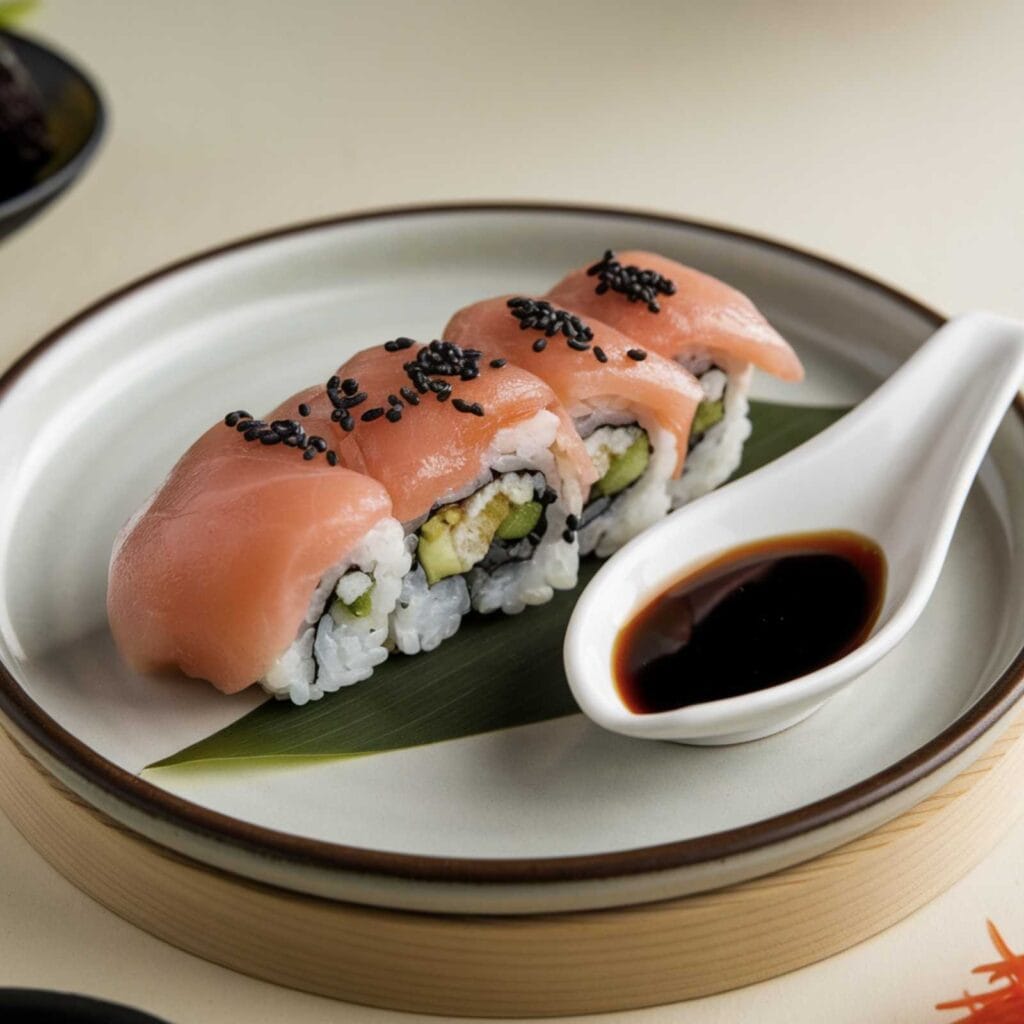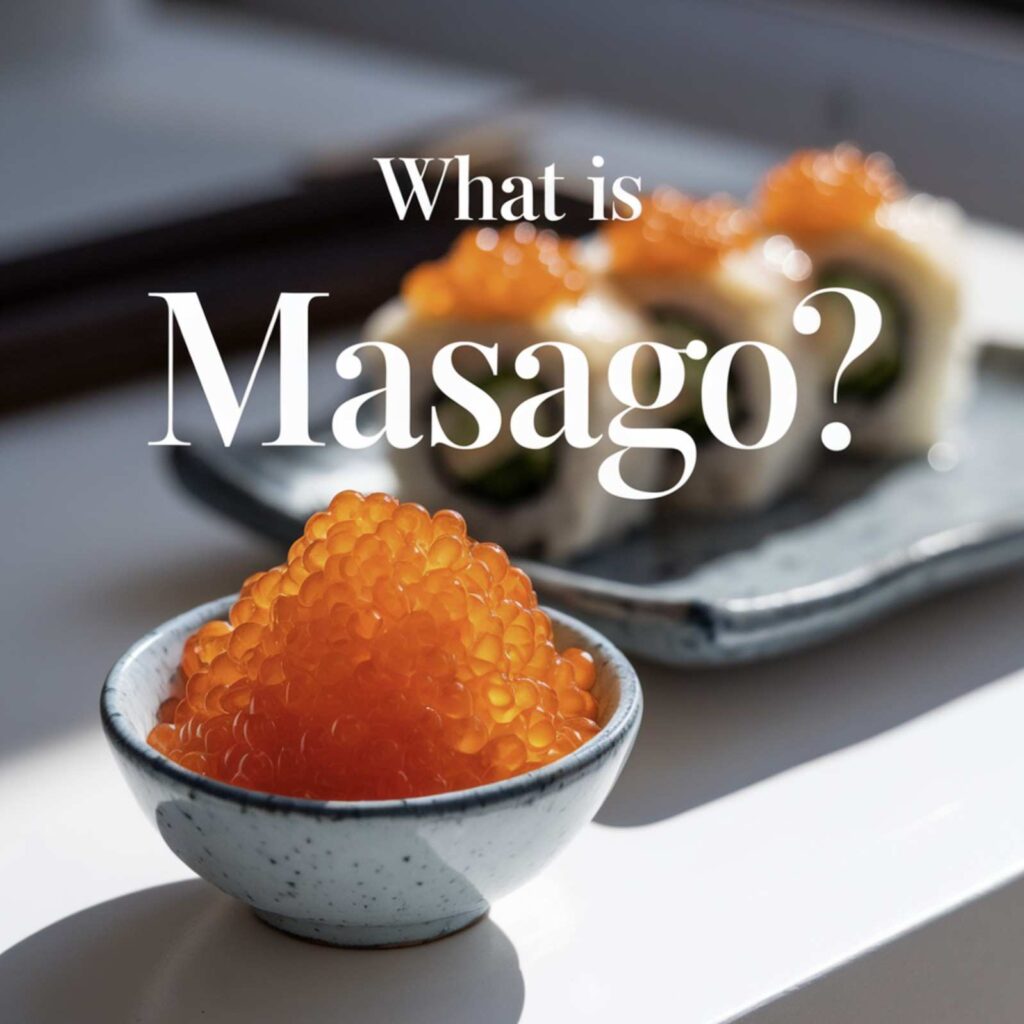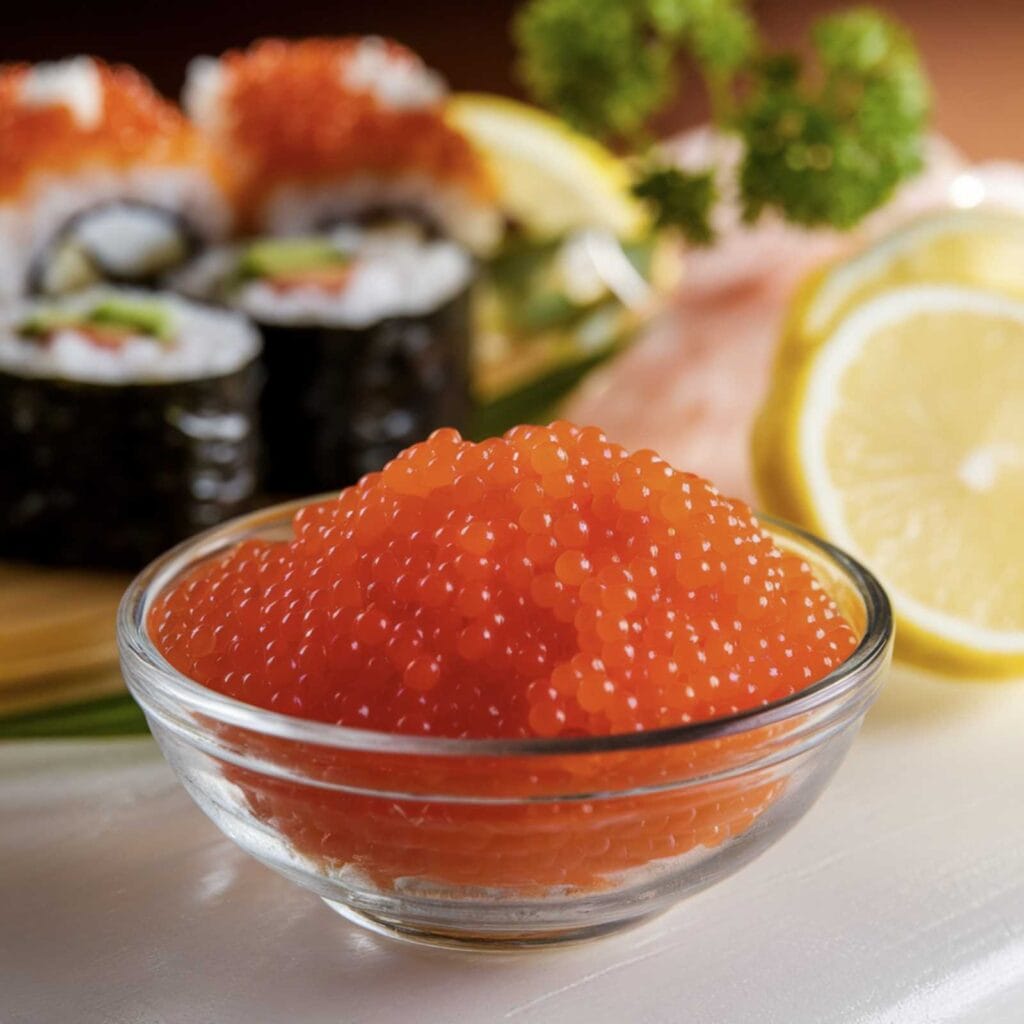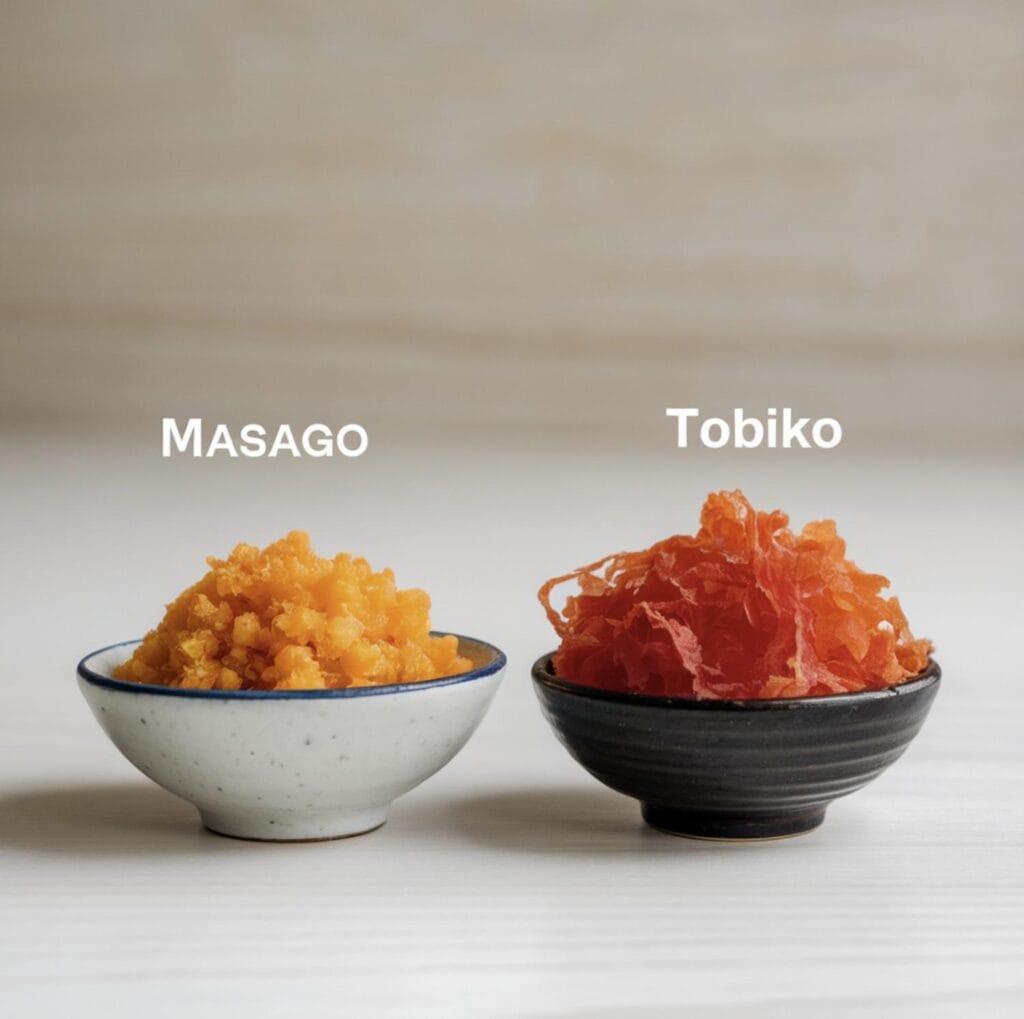Masago is a vibrant and versatile ingredient that has earned its place as a beloved staple in Japanese cuisine. It is also gaining popularity in kitchens around the world. Renowned for its bright orange color, delicate crunch, and subtle umami flavor, it brings a distinct character to the dishes it graces. Whether sprinkled on sushi rolls, added to poke bowls, or blended into creamy sauces, it elevates meals in both flavor and appearance.
Beyond its versatility, it carries cultural and nutritional significance. This has made it a favorite among chefs and food enthusiasts alike. This guide explores everything you need to know about it, from its origins and preparation to its modern culinary uses. Additionally, it offers creative tips for using this delightful seafood ingredient, ensuring you can enjoy its rich flavor and texture.
What is Masago?
Masago, also known as capelin roe, refers to the eggs of the capelin fish. This small, silvery forage species lives in cold waters, including the North Atlantic and Arctic Oceans. These tiny eggs are prized for their delicate, briny flavor and signature texture, making them popular in a wide range of dishes, especially Japanese cuisine.
The capelin fish plays a critical role in marine ecosystems. It serves as a food source for larger predators such as cod, seals, and seabirds. The roe is harvested during the fish’s spawning season to ensure sustainability while maintaining high quality. While it’s natural color is pale orange, dyes are often added to enhance its visual appeal, further increasing its allure in culinary presentations.
How is Masago Made?
Producing masago involves a meticulous process that preserves its delicate properties. During the capelin’s spawning season, workers carefully harvest female fish and extract the roe by hand to minimize damage to the eggs. After collecting the roe, they thoroughly clean it to remove impurities and prepare it for curing.
The curing process, typically done with salt, enhances the roe’s natural briny flavor and preserves it for extended use. This step also increases its shelf life, making it suitable for transportation and use worldwide.
Beyond curing, producers often infuse it with various flavors and colors to create unique variations. For example, wasabi-infused it delivers a spicy kick, squid ink-dyed it offers a dramatic black hue and earthy flavor, and chili-infused it adds a bold, spicy twist that complements contemporary dishes. These adaptations expand its culinary applications and turn it into a visually striking addition to any plate.
Why is Masago So Popular in Japanese Cuisine?
Japanese cuisine emphasizes harmony, flavor, and presentation, which explains why masago fits seamlessly into this culinary tradition. Its vibrant orange hue adds visual interest to sushi rolls and sashimi, while its mild flavor pairs effortlessly with a variety of ingredients. Furthermore, its small, crunchy texture provides an enjoyable contrast to softer components like rice or raw fish.
Culinary Applications
Masago’s adaptability makes it a favorite among chefs and home cooks alike. Its uses extend far beyond traditional sushi rolls. For example:
- Sushi and Sashimi: Often used as a topping for sushi rolls or a garnish for sashimi, itenhances both flavor and presentation.
- Rice Bowls: Sprinkling it over poke bowls or chirashi adds an extra layer of texture and a salty accent.
- Seaweed Salads: It pairs beautifully with the fresh flavors of seaweed or cucumber salads.
- Sauces and Dips: it can be mixed into mayonnaise, cream sauces, or aioli for a seafood-inspired kick.
- Soups: Adding a dash of it to miso soup or ramen provides a burst of umami.
For more inspiration on incorporating seafood into your meals, explore our recipes for Authentic Pad Thai or Thai Coconut Curry Mussels.
What Does Masago Taste Like?
Masago boasts a mild yet distinctive flavor that has made it a favorite among seafood lovers and culinary adventurers alike. Its flavor profile is delicately salty, with a subtle hint of sweetness and an umami undertone that complements a wide variety of dishes. This balance makes it approachable, even for individuals who might be unfamiliar with seafood or hesitant to try fish roe.
One of its most appealing characteristics is its crunchy texture, which contrasts beautifully with soft or creamy foods like avocado, sushi rice, or pasta. This interplay of textures creates a dining experience that is both satisfying and memorable, elevating even simple recipes to gourmet levels.
People often describe it as subtler and less intense in flavor compared to other types of fish roe, such as tobiko or caviar. This quality makes it an excellent choice for introducing fish roe to newcomers or those with a delicate palate. Additionally, it pairs well with various ingredients, whether used in traditional Japanese dishes or contemporary culinary creations.
Health Benefits of Masago
Masago is both a delightful culinary ingredient and a nutritious one. It is packed with essential nutrients that support overall health and well-being. Like many seafood products, it is rich in high-quality protein and omega-3 fatty acids, which are crucial for a balanced diet. Here are the key health benefits of adding it to your meals:
- Protein-Rich: Masago provides a significant amount of protein. This makes it ideal for supporting muscle repair and growth, especially for active individuals.
- Omega-3 Fatty Acids: These healthy fats contribute to heart health, brain function, and reduced inflammation, promoting long-term wellness.
- Vitamins and Minerals: Masago contains essential nutrients like vitamin B12, selenium, and magnesium. These help boost energy, strengthen the immune system, and regulate metabolism.
- Low-Calorie Option: Masago is low in calories, making it a guilt-free addition for those managing their weight.
However, masago is high in sodium due to the curing process. For this reason, individuals watching their sodium intake, such as those with high blood pressure, should consume it in moderation.
Masago vs. Tobiko: What Sets Them Apart?
Although masago and tobiko (flying fish roe) are often used interchangeably, they have clear differences. These distinctions make each better suited for different culinary uses.
| Feature | Masago | Tobiko |
|---|---|---|
| Source | Capelin fish | Flying fish |
| Texture | Smaller, softer | Larger, crunchier |
| Flavor | Mild, slightly sweet | Robust, briny |
| Color | Naturally pale orange, often dyed | Naturally bright red or black |
| Price | More affordable | Slightly more expensive |
Masago is a more affordable choice for home cooks and chefs experimenting with fish roe. Its softer texture and milder flavor make it perfect for dishes that need balance. On the other hand, tobiko’s crunch and stronger flavor stand out in bold, robust recipes. Both are excellent in their own ways, but masago provides a cost-effective option for those exploring new culinary horizons.
Creative Variations
Masago’s versatility goes beyond its traditional form. It can be infused with different flavors and colors, making it a valuable ingredient in innovative recipes. These variations not only enhance its aesthetic appeal but also add unique tastes to various dishes.
- Spicy Masago: This chili-infused variation delivers a fiery kick. It pairs wonderfully with creamy pastas or spicy sushi rolls. Its bold flavor adds depth and is perfect for anyone who enjoys heat in their meals.
- Wasabi Masago: Blended with wasabi, this version offers a sharp, pungent flavor. It complements sashimi or salads beautifully. The vibrant green color also adds visual interest to any dish.
- Squid Ink Masago: Dyed black and infused with squid ink, this option has a deeper, earthier flavor. Its dramatic appearance makes it ideal for gourmet presentations.
These variations can transform simple meals into sophisticated dining experiences. For instance, spicy masago adds layers of heat and flavor to creamy seafood pasta. Similarly, a garnish of wasabi masago on a poke bowl introduces a zesty twist. With these options, the culinary potential of masago is practically limitless.
FAQs
Is Masago Really Fish Eggs?
Yes, masago refers to the eggs of the capelin fish, a small forage species found in cold waters such as the North Atlantic and Arctic Oceans. Harvesters carefully collect, clean, and cure these tiny eggs before seasoning them for culinary use. Their delicate texture and mild flavor make them an excellent addition to various dishes, from sushi to salads. Because of its versatility, chefs around the world have embraced masago as a staple in Japanese cuisine and a global favorite for enhancing both flavor and presentation.
Is Masago a Type of Caviar?
Technically, no. While both masago and caviar are types of fish roe, the term “caviar” specifically refers to the eggs of sturgeon fish. Caviar is rarer, more labor-intensive to harvest, and significantly more expensive than masago. By contrast, producers harvest masago from capelin, a more abundant fish, which makes it a budget-friendly alternative to traditional caviar. Despite this distinction, many chefs and home cooks use masago as a caviar substitute in recipes because of its similar appearance and flavor-enhancing qualities.
What Does Masago Taste Like?
Masago has a mild, briny taste that is slightly sweet with a subtle hint of umami. Its flavor is less intense than tobiko or caviar, making it an excellent option for individuals who are new to fish roe. Additionally, masago’s light crunch adds a delightful textural element to dishes, making it ideal for pairing with creamy or tender ingredients like avocado, sushi rice, or pasta.
Is Masago Served Raw?
Although masago is often served raw, it undergoes a curing process with salt that enhances its flavor and preserves it for safe consumption. This curing ensures that masago maintains its signature briny taste and crunchy texture while remaining fresh for culinary use. The curing process also adds a touch of complexity to its flavor profile, making it a versatile ingredient in both traditional and contemporary dishes.
Why is Masago Cheaper Than Caviar?
Masago is more affordable than caviar because capelin fish are abundant and easier to harvest compared to sturgeon. Sturgeon require extensive conservation efforts, strict regulation, and meticulous care, which dramatically increases the cost of their roe. By contrast, capelin are more readily available and sustainable to harvest, making masago a cost-effective yet flavorful alternative to luxury fish roe like caviar or tobiko.
Is Masago a Healthy Choice?
Yes, masago is a highly nutritious ingredient. It is rich in protein, which supports muscle growth and repair, and omega-3 fatty acids, which promote heart and brain health. Masago also contains essential vitamins and minerals, such as vitamin B12, selenium, and magnesium. These nutrients contribute to energy production, immune system support, and overall well-being.
However, it’s worth noting that masago is high in sodium due to its curing process. Individuals managing their sodium intake, such as those with high blood pressure, should consume it in moderation to maintain a balanced diet. Despite this, you can make masago a worthy addition to a variety of meals by enjoying it in appropriate portions.
Conclusion

Masago is a versatile, nutritious ingredient that adds flavor, texture, and visual appeal to countless dishes. Its subtle umami flavor, bright orange hue, and crunchy texture make it a standout in Japanese cuisine and beyond. As a more affordable and accessible alternative to tobiko or caviar, it is an excellent choice for both home cooks and professional chefs. Whether sprinkled over sushi, blended into creamy sauces, or used as a garnish for poke bowls, masago offers endless opportunities for culinary creativity.
If you want to incorporate masago into your meals, its mild flavor pairs well with fresh vegetables and delicate seafood. Its variations, like spicy masago or squid ink masago, let you experiment with bold flavors and unique presentations. For more ideas, check out Kelly Loves Masago Recipes for insights into sushi and other seafood dishes.
For additional inspiration, try recipes like Authentic Pad Thai or Thai Coconut Curry Mussels. These showcase how seafood can elevate everyday meals into something extraordinary.
For further reading on masago, its benefits, and creative uses, visit Yummy Mummy Kitchen on Masago for expert advice and delicious ideas.





